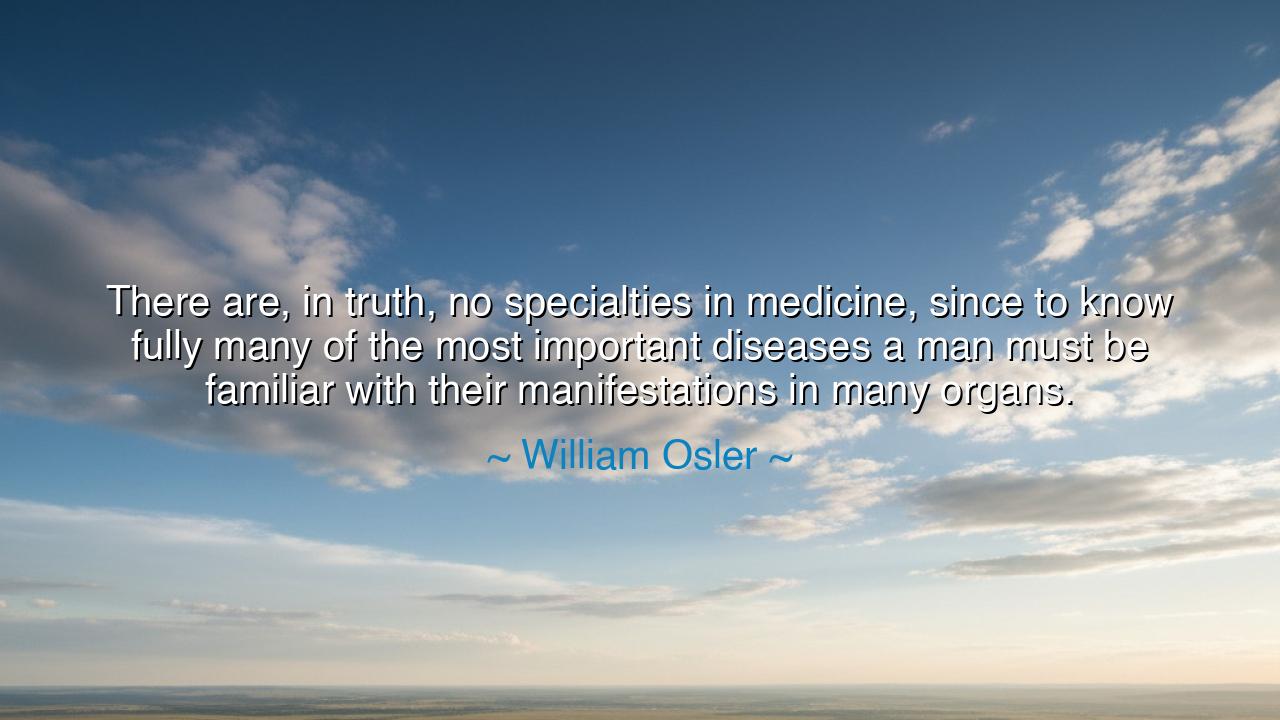
There are, in truth, no specialties in medicine, since to know
There are, in truth, no specialties in medicine, since to know fully many of the most important diseases a man must be familiar with their manifestations in many organs.






The words of Sir William Osler—“There are, in truth, no specialties in medicine, since to know fully many of the most important diseases a man must be familiar with their manifestations in many organs”—carry the weight of a sage’s wisdom, spoken from the heart of one who dedicated his life to the healing of humankind. They remind us that truth in medicine cannot be divided into narrow compartments, for the human body is not a scattered collection of parts, but a living, breathing whole. Disease does not respect the borders of specialties; it weaves itself through systems, organs, and tissues, revealing its nature only to those who look at the body in its unity.
In Osler’s time, the late 19th and early 20th centuries, medicine was becoming increasingly fragmented. The rise of specialization brought depth, but also the danger of narrowness. Osler, the great physician and teacher, sought to remind his students that no organ lives in isolation, and no disease belongs to one chamber of the body alone. The heart, the lungs, the brain, the blood—all are bound together. To see clearly, the healer must look not only at the part but at the whole, not only at the symptom but at the person. This is the truth he proclaimed: that medicine is one, just as life itself is one.
History itself provides testimony to this wisdom. Consider the great pandemic of tuberculosis, once called the “white plague.” In some, it ravaged the lungs; in others, it gnawed at the bones; in others still, it clouded the mind. The disease could not be understood by a lung doctor alone, nor by a bone specialist, nor by a psychiatrist—it demanded the eye of a physician who could see its many faces, who could recognize that one enemy was wearing a hundred masks. Without this broader vision, countless lives would have been lost in confusion. Here we see Osler’s truth brought to life: only by seeing the whole can the healer truly heal.
Even in more recent times, this principle stands firm. HIV/AIDS, when it first appeared, confounded specialists. Was it a disease of the immune system? Of the skin? Of the lungs? Of the nervous system? In truth, it was all of these. Only those who dared to see the connections across the body, who resisted the temptation to see it as “someone else’s specialty,” began to unravel its nature. Their vision, broad and integrative, reflected the very teaching Osler left behind: that disease is not confined, and neither should be the mind of the physician.
But let us not think this wisdom applies to medicine alone. It speaks also to the way we live and learn in every field. Knowledge is one body, and though men divide it into disciplines, the truth is that life itself knows no such boundaries. To understand politics, one must know history. To understand history, one must know culture. To understand culture, one must know the heart of man. So it is in medicine, and so it is in all learning: the deeper you go into one thing, the more you must understand many things.
The lesson, therefore, is clear: do not let the walls of specialty blind you to the unity of life. If you are a physician, see your patient not as a heart, or a lung, or a kidney, but as a whole person in whom all systems are joined. If you are a student, do not despise learning outside your chosen field, for it may hold the key to the puzzle you seek to solve. And if you are a seeker of wisdom, train your eyes to see the connections, for wisdom dwells not in fragments but in wholeness.
Therefore, O seeker, remember Osler’s words: in truth, there are no specialties. Medicine is one, knowledge is one, life is one. The divisions we create are tools, but they are not reality. Walk, then, in the path of the whole. Cultivate breadth as well as depth. See each part as connected to the whole, each symptom as the voice of the body entire. In this way, you will be not merely a specialist, but a healer; not merely a knower of facts, but a lover of wisdom. And your work, like Osler’s, will endure as truth.






AAdministratorAdministrator
Welcome, honored guests. Please leave a comment, we will respond soon